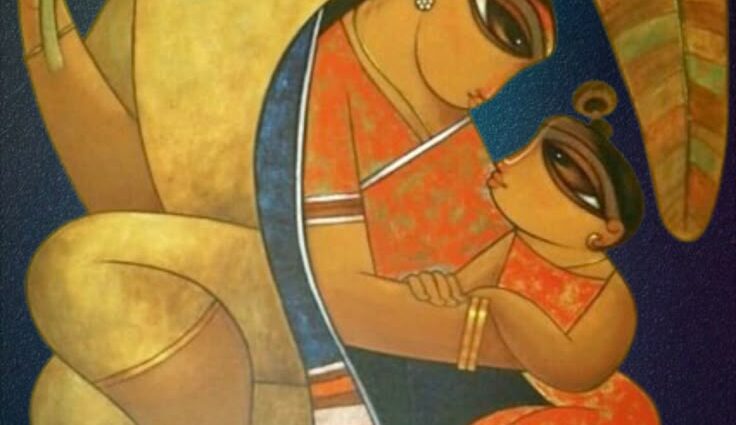This painting is a beautiful example of modern Indian art that merges traditional themes with contemporary stylistic elements. It appears to be inspired by folk or tribal art styles, particularly those seen in Madhubani or Kalighat paintings, yet executed in a modernist form. Here’s a detailed interpretation of the artwork:
Subject & Theme:
The painting depicts a tender and intimate family moment involving three figures: a man, a woman, and a child. It appears to celebrate familial love and warmth in a rural or pastoral setting. The figures are intertwined, suggesting closeness, protection, and affection.
- The Man: He is seated and holds a large banana leaf over the family, likely providing shelter or shade — symbolizing protection and care.
- The Woman: Dressed in a traditional sari with intricate patterns, she embraces the child with a gentle expression, evoking nurturing and motherhood.
- The Child: Seated on the mother’s lap, the child looks lovingly at her, creating a strong emotional loop between the three characters.
Artistic Style:
- Form & Proportion: The figures are stylized rather than realistic. Their elongated limbs, almond-shaped eyes, and minimal facial features reflect a traditional Indian artistic sensibility, possibly influenced by Jamini Roy’s works.
- Lines & Contours: The lines are clean and bold, with curving, flowing forms that bring rhythm to the composition.
- Color Palette: The use of earthy tones — warm oranges, deep blues, browns, and muted golds — gives a sense of calm and groundedness. These colors are often associated with Indian soil and culture.
- Texture: The painter uses a flat but richly textured style, giving the image a mural-like effect. The fabric details, especially in the sari, show delicate patterns that add to the visual richness.
Symbolism:
- Banana Leaf: A culturally significant motif in many Indian traditions, representing simplicity, nature, and sustenance. Here, it acts like an umbrella, suggesting shelter and care.
- Embrace: The intertwined poses symbolize unity and unconditional love. The triangle formed by the figures may also subtly imply stability and foundation — the strength of family.
- Traditional Attire: Reinforces cultural identity and rootedness in heritage.
Mood & Emotion:
The painting exudes warmth, security, and peace. The gentle postures and close body language create a feeling of deep connection and mutual support. The large, calm eyes are expressive despite the minimalistic detailing, radiating serenity and introspection.
Cultural Context:
This type of work is common in Indian contemporary art that seeks to revisit traditional themes of rural life, motherhood, and family bonds. It connects modern aesthetics with timeless values. The influence of indigenous art forms blended with cubist and expressionist touches showcases a revivalist yet innovative approach.
Possible Artist Influences:
Thota Vaikuntam or Laxma Goud: Artists who often paint village life with a stylized, affectionate touch.
Jamini Roy: Known for his use of folk styles and stylized figures with bold lines.
